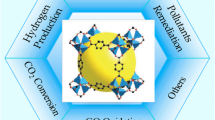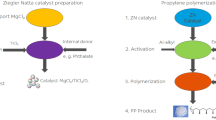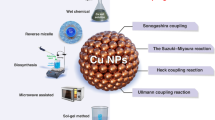Abstract
Functionalized metal-organic framework containing a heteropolyacid such as dodecatungstophosphoric (DTP)-encapsulated MOF-5 was synthesized by an in situ method and then ruthenium was incorporated by incipient wetness impregnation. A multifunctional heterogeneous catalyst, 1% Ru-15%DTP@MOF-5 with active acid and the metal sites make it the most efficient catalyst. For acid sites, dodecatungstophosphoric acid (DTP) was encapsulated into MOF-5 and ruthenium was loaded as metal sites. Its activity was examined in the one-pot synthesis of allyl 4-cyclohexanebutyrate, a flavoring agent, by esterification of 4-phenylbutyric acid with allyl alcohol followed by aromatic ring hydrogenation using molecular hydrogen. Esterification of 4-phenylbutyric acid with allyl alcohol gives allyl 4-phenylbutyrate which is further hydrogenated to give allyl 4-cyclohexanebutyrate. The octahedral cubic morphology of MOF-5 was retained even after DTP encapsulation and loading of ruthenium. Catalyst screening for esterification step was carried out by varying loadings of DTP (10, 15, and 20%) on MOF-5. Among these, 15% DTP-loaded MOF-5 showed the best catalytic activity. For selective aromatic ring hydrogenation, different metals such as Pd, Re, Ru, and Rh were examined and it was found that the Ru-based catalyst resulted in the highest conversion of allyl 4-phenylbutyrate (89.63%) and selectivity for allyl 4-cyclohexanebutyrate (96.52%). 1% Ru-15% DTP@MOF-5 catalyst was thermally stable and five times reusable. For both the steps, the kinetics was studied using the Langmuir-Hinshelwood-Hougen-Watson (LHHW) mechanism and the apparent activation energy for esterification was calculated as 13.34 kcal/mol and that for hydrogenation as 14.87 kcal/mol.

Selectivity engineering in catalysis by ruthenium nanoparticles supported on heteropolyacid-encapsulated MOF-5: one-pot synthesis of allyl 4-cyclohexanebutyrate and kinetic modeling





























Similar content being viewed by others
Abbreviations
- DTP:
-
Dodecatungstophosphoric acid
- TEA:
-
Triethyl amine
- DMF:
-
N,N-Dimethylformamide
- HPA:
-
Heteropolyacid
- FCC:
-
Face-centered-cubic
- A :
-
4-Phenylbutyric acid
- B :
-
Allyl alcohol
- C :
-
Allyl 4-phenylbutyrate
- D :
-
Water
- G :
-
Allyl 4-cyclohexanebutyrate
- H :
-
Hydrogen
- K A :
-
adsorption constant for A (L/mol)
- KB :
-
adsorption constant for B (L/mol)
- K C :
-
adsorption constant for C (L/mol)
- K H :
-
adsorption constant for hydrogen (L/mol)
- CA :
-
Concentration of A (mol/L)
- C B :
-
Concentration of B (mol/L)
- C C :
-
Concentration of C (mol/L)
- C D :
-
Concentration of D (mol/L)
- C E :
-
Concentration of E (mol/L)
- S 1 :
-
Acid site
- S 2 :
-
Metal site
- w:
-
Catalyst loading (g/L)
- k, k 1 :
-
Rate constants with appropriate units
- M :
-
Mole ratio of intial concentration of B to A, CB0/CA0
- C t :
-
Total concentration of catalytic sites (mol/L)
- XA :
-
Fractional conversion of A
- XC :
-
Fractional conversion of C
References
M.H. Yap, K.L. Fow, G.Z. Chen, Synthesis and applications of MOF-derived porous nanostructures. Green Energy Environ. 2, 218–245 (2017). https://doi.org/10.1016/j.gee.2017.05.003
H.V. Doan, H. Amer Hamzah, P. Karikkethu Prabhakaran, C. Petrillo, V.P. Ting, Hierarchical Metal–Organic Frameworks with Macroporosity: Synthesis, Achievements, and Challenges. Nano-Micro Lett. 11, 54 (2019). https://doi.org/10.1007/s40820-019-0286-9
H. Zhu, D. Liu, The synthetic strategies of metal-organic framework membranes, films and 2D MOFs and their applications in devices. J. Mater. Chem. A 7, 21004–21035 (2019). https://doi.org/10.1039/c9ta05383b
M.S. Denny, J.C. Moreton, L. Benz, S.M. Cohen, Metal–organic frameworks for membrane-based separations. Nat. Rev. Mater. 1, 16078 (2016). https://doi.org/10.1038/natrevmats2016.78
A. Amiri, F. Ghaemi, B. Maleki, Hybrid nanocomposites prepared from a metal-organic framework of type MOF-199(cu) and graphene or fullerene as sorbents for dispersive solid phase extraction of polycyclic aromatic hydrocarbons. Microchim. Acta 186, 131 (2019). https://doi.org/10.1007/s00604-019-3246-7
R.S. Malkar, H. Daly, C. Hardacre, G.D. Yadav, Aldol condensation of 5-Hydroxymethylfurfural to fuel precursor over novel aluminum exchanged-DTP@ZIF-8. ACS Sustain. Chem. Eng. 7, 16215–16224 (2019). https://doi.org/10.1021/acssuschemeng.9b02939
L. Li, Q. Yang, S. Chen, X. Hou, B. Liu, J. Lu, H.L. Jiang, Boosting selective oxidation of cyclohexane over a metal-organic framework by hydrophobicity engineering of pore walls. Chem. Commun. 53, 10026–10029 (2017). https://doi.org/10.1039/c7cc06166h
J. Han, D. Wang, Y. Du, S. Xi, J. Hong, S. Yin, Z. Chen, T. Zhou, R. Xu, Metal-organic framework immobilized cobalt oxide nanoparticles for efficient photocatalytic water oxidation. J. Mater. Chem. A 3, 20607–20613 (2015). https://doi.org/10.1039/c5ta04675k
R.S. Malkar, G.D. Yadav, Synthesis of cinnamyl benzoate over novel heteropoly acid encapsulated ZIF-8. Appl. Catal. A Gen. 560, 54–65 (2018). https://doi.org/10.1016/j.apcata.2018.04.038
T.W. Murinzi, T.A. Clement, V. Chitsa, G. Mehlana, Copper oxide nanoparticles encapsulated in HKUST-1 metal-organic framework for electrocatalytic oxidation of citric acid. J. Solid State Chem. 268, 198–206 (2018). https://doi.org/10.1016/j.jssc.2018.09.003
R.S. Malkar, H. Daly, C. Hardacre, G.D. Yadav, Novelty of iron-exchanged heteropolyacid encapsulated inside ZIF-8 as an active and superior catalyst in the esterification of furfuryl alcohol and acetic acid. React. Chem. Eng. 4, 1790–1802 (2019). https://doi.org/10.1039/c9re00167k
M. Kassymova, A. De Mahieu, S. Chaemchuen, P. Demeyere, B. Mousavi, S. Zhuiykov, M.S. Yusubov, F. Verpoort, Post-synthetically modified MOF for the A3-coupling reaction of aldehyde, amine, and alkyne. Catal. Sci. Technol. 8, 4129–4140 (2018). https://doi.org/10.1039/c8cy00662h
N.T.S. Phan, K.K.A. Le, T.D. Phan, MOF-5 as an efficient heterogeneous catalyst for Friedel-Crafts alkylation reactions. Appl. Catal. A Gen. 382, 246–253 (2010). https://doi.org/10.1016/j.apcata.2010.04.053
H. Zhao, H. Song, L. Chou, Nickel nanoparticles supported on MOF-5: Synthesis and catalytic hydrogenation properties. Inorg. Chem. Commun. 15, 261–265 (2012). https://doi.org/10.1016/j.inoche.2011.10.040
R.A. Rather, Z.N. Siddiqui, Silver phosphate supported on metal–organic framework (Ag3PO4@MOF-5) as a novel heterogeneous catalyst for green synthesis of indenoquinolinediones. Appl. Organomet. Chem. 33, 1–14 (2019). https://doi.org/10.1002/aoc.5176
F. Guo, S. Yang, Y. Liu, P. Wang, J. Huang, W.Y. Sun, Size engineering of metal-organic framework MIL-101(Cr)-Ag hybrids for photocatalytic CO2 reduction. ACS Catal. 9, 8464–8470 (2019). https://doi.org/10.1021/acscatal.9b02126
K.I. Otake, J. Ye, M. Mandal, T. Islamoglu, C.T. Buru, J.T. Hupp, M. Delferro, D.G. Truhlar, C.J. Cramer, O.K. Farha, Enhanced activity of heterogeneous Pd(II) catalysts on acid-functionalized metal-organic frameworks. ACS Catal. 9, 5383–5390 (2019). https://doi.org/10.1021/acscatal.9b01043
A.M. Abdel-Mageed, B. Rungtaweevoranit, M. Parlinska-Wojtan, X. Pei, O.M. Yaghi, R. Jürgen Behm, Highly active and stable single-atom Cu catalysts supported by a metal-organic framework. J. Am. Chem. Soc. 141, 5201–5210 (2019). https://doi.org/10.1021/jacs.8b11386
Y. Zhang, H. Chen, Y. Pan, X. Zeng, X. Jiang, Z. Long, X. Hou, Cerium-based UiO-66 metal-organic frameworks explored as efficient redox catalysts: titanium incorporation and generation of abundant oxygen vacancies. Chem. Commun. 55, 13959–13962 (2019). https://doi.org/10.1039/c9cc06562h
M. Mueller, S. Hermes, K. Kaehler, M. Muhler, R.A. Fischer, Loading of MOF-5 with Cu and ZnO nanoparticles by gas-phase infiltration with organometallic precursors: Properties of Cu/ZnO/MOF as catalysts for methanol synthesis. Chem. Mater. 20, 4576–4587 (2008)
A. Schejn, T. Mazet, V. Falk, L. Balan, L. Aranda, G. Medjahdi, R. Schneider, Fe3O4@ZIF-8: Magnetically recoverable catalysts by loading Fe3O4 nanoparticles inside a zinc imidazolate framework. Dalton Trans. 44, 10136–10140 (2015). https://doi.org/10.1039/c5dt01191d
J. Feng, Y. Zhong, M. Xie, M. Li, S. Jiang, Using MOF-808 as a promising support to immobilize Ru for Selective Hydrogenation of levulinic acid to γ-Valerolactone. Catal. Lett. (2020). https://doi.org/10.1007/s10562-020-03277-x
T. Sawai, T. Yonehara, A. Yonezawa, M. Sano, T. Suzuki, T. Miyake, Preparation of PD/MOF and RU/MOF catalysts and catalytic performance for hydrogenation and cross-coupling reactions. J. Japan Pet. Inst. 57, 58–64 (2014). https://doi.org/10.1627/jpi.57.58
T. Zhang, Z. Wang, Q. Zhao, F. Li, W. Xue, Partial hydrogenation of benzene to cyclohexene over Ru-Zn/MCM-41. J. Nanomater. 2015, 1–8 (2015). https://doi.org/10.1155/2015/670896
P. Guo, S. Liao, X. Tong, Heterogeneous nickel catalysts derived from 2D metal-organic frameworks for regulating the selectivity of furfural hydrogenation. ACS Omega. 4, 21724–21731 (2019). https://doi.org/10.1021/acsomega.9b02443
Y. Long, S. Song, J. Li, L. Wu, Q. Wang, Y. Liu, R. Jin, H. Zhang, Pt/CeO2@MOF Core@Shell Nanoreactor for selective hydrogenation of furfural via the channel screening effect. ACS Catal. 8, 8506–8512 (2018). https://doi.org/10.1021/acscatal.8b01851
X. Hu, K. Ma, A. Sabbaghi, X. Chen, A. Chatterjee, F.L.Y. Lam, Mild acid functionalization of metal-organic framework and its catalytic effect on esterification of acetic acid with n-butanol. Mol. Catal. 482, 110635 (2020). https://doi.org/10.1016/j.mcat.2019.110635
F.G. Cirujano, A. Corma, F.X. Llabrés i Xamena, Conversion of levulinic acid into chemicals: synthesis of biomass derived levulinate esters over Zr-containing MOFs. Chem. Eng. Sci. 124, 52–60 (2015). https://doi.org/10.1016/j.ces.2014.09.047
G.D. Yadav, Synergism of clay and heteropoly acids as nano-catalysts for the development of green processes with potential industrial applications. Catal. Sury. Asia 9, 117–137 (2005)
V.V. Bokade, G.D. Yadav, Synthesis of bio-diesel and bio-lubricant by transesterification of vegetable oil with lower and higher alcohols over heteropolyacids supported by clay (K-10). Process. Saf. Environ. Prot. 85(5), 372–377 (2007)
M.S. Tiwari, G.D. Yadav, Novel aluminium exchanged dodecatungstophosphoric acid supported on K-10 clay as catalyst: benzoylation of diphenyloxide with benzoic anhydride. RSC Adv. 6, 49091–49100 (2016)
D.P. Wagh, G.D. Yadav, Multi-functional Fe-Al0.66DTP/MCF catalyst in cascade engineered synthesis of the drug butamben: novelty of catalyst, reaction kinetics and mechanism. Mol. Catal. 483, 110711 (2020)
G.D. Yadav, N.S. Asthana, V.S. Kamble, Cesium-substituted dodecatungstophosphoric acid on K-10 clay for benzoylation of anisole with benzoyl chloride. J. Catal. 217, 88–99 (2003)
G.D. Yadav, H.G. Manyar, Novelties of synthesis of acetoveratrone using heteropoly acid supported on hexagonal mesoporous silica. Microporous Mesoporous Mater. 63, 85–96 (2003)
R. Tayebee, M. Fattahi Abdizadeh, N. Erfaninia, A. Amiri, M. Baghayeri, R.M. Kakhki, B. Maleki, E. Esmaili, Phosphotungstic acid grafted zeolite imidazolate framework as an effective heterogeneous nanocatalyst for the one-pot solvent-free synthesis of 3,4-dihydropyrimidinones. Appl. Organomet. Chem. 33, 1–10 (2019). https://doi.org/10.1002/aoc.4959
A. Jamshidi, B. Maleki, F.M. Zonoz, R. Tayebee, HPA-dendrimer functionalized magnetic nanoparticles (Fe3O4@D-NH2-HPA) as a novel inorganic-organic hybrid and recyclable catalyst for the one-pot synthesis of highly substituted pyran derivatives. Mater. Chem. Phys. 209, 46–59 (2018). https://doi.org/10.1016/j.matchemphys.2018.01.070
B. Maleki, A.V. Mofrad, R. Tayebee, A. Khojastehnezhad, H. Alinezhad, E. Rezaei Seresht, One-pot synthesis of 1,4-dihydropyridine derivatives catalyzed by silica-coated magnetic NiFe2O4 nanoparticles-supported H14[NaP5W30O110]. Russ. J. Gen. Chem. 87, 2922–2929 (2017). https://doi.org/10.1134/S1070363217120325
A. Jamshidi, F. Mohammadi Zonoz, B. Maleki, Synthesis and characterization of a new nano ionic liquid based on dawson-type polyoxometalate and its application in the synthesis of symmetrical N,N′-alkylidene bisamides. Polycycl. Aromat. Compd. 40, 875–888 (2020). https://doi.org/10.1080/10406638.2018.1504094
S. Opelt, S. Türk, E. Dietzsch, A. Henschel, S. Kaskel, E. Klemm, Preparation of palladium supported on MOF-5 and its use as hydrogenation catalyst. Catal. Commun. 9, 1286–1290 (2008). https://doi.org/10.1016/j.catcom.2007.11.019
L. Shi, T. Fan, Isomerization of n-hexane over MOF-5 supported molybdenum carbide, Conf. Proc. - 2009 AIChE Annu. Meet. AIChE. (2009)
A.M.S.T.T. Dang, Y. Zhu, S.C. Ghosh, A. Chen, C.L.L. Chai, aminocarbonylation of aryI iodides using MOF-5-supported Pd nanoparticles. Synfacts 8, 0462 (2012). https://doi.org/10.1055/s-0031-1290555
Luzan, S. M.; Talyzin, A. V. Hydrogen Adsorption in Pt Catalyst/MOF-5 Materials. Microporous Mesoporous Mater. 135, 201–205 (2010). https://doi.org/10.1016/j.micromeso.2010.07.018
U. Ravon, M.E. Domine, C. Gaudillère, A. Desmartin-Chomel, D. Farrusseng, MOF-5 as Acid Catalyst with Shape Selectivity Properties, Stud Surf Sci Catal. 174, 467-470 (2008). https://doi.org/10.1016/S0167-2991(08)80242-X
B.L. Xiang, L. Fu, Y. Li, Y. Liu, Preparation of Fe(II)/MOF-5 catalyst for highly selective catalytic hydroxylation of phenol by equivalent loading at room temperature. J. Chem. 2019, 1–10 (2019). https://doi.org/10.1155/2019/8950630
A. Nemati Chelavi, V. Zare-Shahabadi, S. Sayyahi, H. Anaraki-Ardakani, Optimization of the transfer hydrogenation reaction of acetophenone on Ni@MOF-5 nanoparticles using response surface methodology. Res. Chem. Intermed. 46, 445–458 (2020). https://doi.org/10.1007/s11164-019-03959-1
A.K. Chakraborti, B. Singh, S.V. Chankeshwara, A.R. Patel, Protic acid immobilized on solid support as an extremely efficient recyclable catalyst system for a direct and atom economical esterification of carboxylic acids with alcohols. J. Organomet. Chem. 74, 5967–5974 (2009). https://doi.org/10.1021/jo900614s
M.M. Peng, U.J. Jeon, M. Ganesh, A. Aziz, R. Vinodh, M. Palanichamy, H.T. Jang, Oxidation of ethylbenzene using nickel oxide supported metal organic framework catalyst. Bull. Kor. Chem. Soc. 35, 3213–3218 (2014). https://doi.org/10.5012/bkcs.2014.35.11.3213
O.M.Y. Hailian Li, M. Eddaoudi, M. OKeeffe, Design and synthesis of an exceptionally stable and highly porous metal-organic framework. Nature 402, 276–279 (1999)
H.M. Yang, X.L. Song, T.L. Yang, Z.H. Liang, C.M. Fan, X.G. Hao, Electrochemical synthesis of flower shaped morphology MOFs in an ionic liquid system and their electrocatalytic application to the hydrogen evolution reaction. RSC Adv. 4, 15720–15726 (2014). https://doi.org/10.1039/c3ra47744d
R.S. Malkar, G.D. Yadav, Superior activity and selectivity of multifunctional catalyst Pd-DTP@ZIF-8 in one pot synthesis of 3-phenyl propyl benzoate. Inorg. Chim. Acta 490, 282–293 (2019). https://doi.org/10.1016/j.ica.2019.03.012
A. Biswas, S. Paul, A. Banerjee, Carbon nanodots, Ru nanodots and hybrid nanodots: Preparation and catalytic properties. J. Mater. Chem. A 3, 15074–15081 (2015). https://doi.org/10.1039/c5ta03355a
M. Arjmandi, M. Pakizeh, Effects of washing and drying on crystal structure and pore size distribution (PSD) of Zn4O13C24H12 framework (IRMOF-1). Acta Metall. Sin. (English Lett) 26, 597–601 (2013). https://doi.org/10.1007/s40195-013-0105-0
G. Blanita, O. Ardelean, D. Lupu, G. Borodi, M. Miheţ, M. Coroş, M. Vlassa, I. Mişan, I. Coldea, G. Popeneciu, Microwave assisted synthesis of MOF-5 at atmospheric pressure. Rev. Roum. Chim. 56, 583–588 (2011)
J.M. Yang, Q. Liu, W.Y. Sun, Shape and size control and gas adsorption of Ni(II)-doped MOF-5 nano/microcrystals. Microporous Mesoporous Mater. 190, 26–31 (2014). https://doi.org/10.1016/j.micromeso.2014.01.020
Y. Liu, Z. Ng, E.A. Khan, H.K. Jeong, C. bun Ching, Z. Lai, Synthesis of continuous MOF-5 membranes on porous α-alumina substrates. Microporous Mesoporous Mater. 118, 296–301 (2009). https://doi.org/10.1016/j.micromeso.2008.08.054
L. Zhao, Y. Zhang, S. Bi, Q. Liu, Metal-organic framework-derived CeO2-ZnO catalysts for C3H6-SCR of NO: An: In situ DRIFTS study. RSC Adv. 9, 19236–19242 (2019). https://doi.org/10.1039/c9ra03103k
X. Sun, T. Wu, Z. Yan, W.J. Chen, X.B. Lian, Q. Xia, S. Chen, Q.H. Wu, Novel MOF-5 derived porous carbons as excellent adsorption materials for n-hexane. J. Solid State Chem. 271, 354–360 (2019). https://doi.org/10.1016/j.jssc.2019.01.002
S. Akbayrak, S. Özkar, Ruthenium(0) nanoparticles supported on multiwalled carbon nanotube as highly active catalyst for hydrogen generation from ammonia-borane. ACS Appl. Mater. Interfaces 4, 6302–6310 (2012). https://doi.org/10.1021/am3019146
M. Zhang, W. Chen, S.J. Ding, Z.Y. Liu, Y. Huang, Z.W. Liao, D.W. Zhang, Physical and electrical characterization of atomic-layer-deposited Ru nanocrystals embedded into Al2O3 for memory applications. J. Phys. D. Appl. Phys. 41 (2008). https://doi.org/10.1088/0022-3727/41/3/032007
H.K. Hassan, N.F. Atta, M.M. Hamed, A. Galal, T. Jacob, Ruthenium nanoparticles-modified reduced graphene prepared by a green method for high-performance supercapacitor application in neutral electrolyte. RSC Adv. 7, 11286–11296 (2017). https://doi.org/10.1039/c6ra27415c
H. Zhao, H. Song, J. Zhao, J. Yang, L. Yan, L. Chou, The reactivity and deactivation mechanism of Ru@C catalyst over hydrogenation of aromatics to cyclohexane derivatives. ChemistrySelect. 5, 4316–4327 (2020). https://doi.org/10.1002/slct.202000311
S. Toppinen, Liquid-phase hydrogenation kinetics of aromatic hydrocarbon mixtures. Ind. Eng. Chem. Res. 36, 2101–2109 (1997). https://doi.org/10.1021/ie960263v
S. Toppinen, T.K. Rantakylä, T. Salmi, J. Aittamaa, Kinetics of the liquid-phase hydrogenation of benzene and some monosubstituted alkylbenzenes over a nickel catalyst. Ind. Eng. Chem. Res. 35, 1824–1833 (1996). https://doi.org/10.1021/ie9504314
V.I. Isaeva, O.M. Nefedov, L.M. Kustov, Metal–organic frameworks-based catalysts for biomass processing. Catalysts 8 (2018). https://doi.org/10.3390/catal8090368
L. Lu, X.Y. Li, X.Q. Liu, Z.M. Wang, L.B. Sun, Enhancing the hydrostability and catalytic performance of metal-organic frameworks by hybridizing with attapulgite, a natural clay. J. Mater. Chem. A 3, 6998–7005 (2015). https://doi.org/10.1039/c5ta00959f
Acknowledgments
D. P. Wagh acknowledges University Grants Commission (UGC) for awarding the BSR Senior Research Fellowship under its SAP programme in Green Technology. G. D. Yadav acknowledges support from the R. T. Mody Distinguished Professor Endowment, Tata Chemicals Darbari Seth Distinguished Professor of Leadership and Innovation, and J. C. Bose National Fellowship of Department of Science and Technology (DST), Govt. of India.
Author information
Authors and Affiliations
Corresponding author
Ethics declarations
Conflict of interest
The authors declare that they have no competing interest.
Declaration
Not applicable.
Supplementary Information
ESM 1
(DOCX 23 kb)
Rights and permissions
About this article
Cite this article
Wagh, D.P., Yadav, G.D. Selectivity engineering in catalysis by ruthenium nanoparticles supported on heteropolyacid-encapsulated MOF-5: one-pot synthesis of allyl 4-cyclohexanebutyrate and kinetic modeling. emergent mater. 3, 965–988 (2020). https://doi.org/10.1007/s42247-020-00139-5
Received:
Accepted:
Published:
Issue Date:
DOI: https://doi.org/10.1007/s42247-020-00139-5




